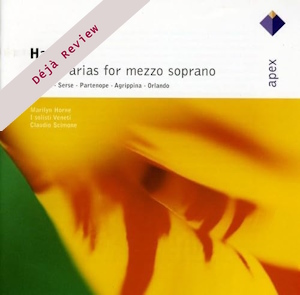
Déjà Review: this review was first published in November 2003 and the recording is still available.
George Frideric Handel (1685-1759)
Arias for mezzo soprano
Marilyn Horne (mezzo soprano)
I solisti Veneti/Claudio Scimone
rec. 1982, Villa Simes, Piazzola, Italy
Apex 2564 605192 [44]
“Arias for mezzo soprano”, it says, and authentically minded readers may already have noted that most of them would be sung by a countertenor these days, being originally for castrati. A little while ago I reviewed a record, “Arias for Farinelli”, by Vivica Genaux, which came with a fascinating essay by René Jacobs in which he argued that the nearest we can get these days to the sound of the castrati is not the countertenor, which he rudely says should really be called a “falsettist”, but the mezzo soprano, who is able to reproduce the strong, warm chest tones in her lower range which contemporary commentators tell us were at the base of the castrato voice production, the voice becoming sweeter and softer as it goes into the higher range. With all due respect for Vivica Genaux’s not inconsiderable achievement, I think Marilyn Horne proves the point rather better. The sheer butch power and richness of her lower chest notes could easily kid you that a man is singing (interestingly in “Lascia ch’io pianga”, where she is actually singing a female role, she avoids using the chest tones on the lower notes), and her middle register, shorn of romantic vibrato, often takes on a countertenor quality. In the upper range, however, there is no attempt to reproduce the sweetness of the old castrati, all is ringingly firm. I’m not sure she was wise to essay a top B but even this is thrilling in a brassy sort of way.
So however you think Handel should be sung, you can hardly deny that this is, in itself, some of the most thrilling singing which his operatic music has received in recorded memory. The sheer accuracy of her passage-work, the ease with which she passes from one register to another (in scale passages which cross between chest and head register I honestly could not say at exactly which note she starts to mix in the chest voice) and the sense of involvement means that this music springs to life as Handel’s operatic music rarely does. Amongst all the fireworks the two famous slow arias, from Serse (the so-called “Largo”) and Rinaldo (“Lascia ch’io pianga”) are built up with a sense of line that no “good old romantic” performance could have bettered; only in the Agrippina aria did I feel that delicacy and charm are not quite her line.
These days Italian period-instrument groups are catching up on their Northern European counterparts with a hard-hitting, staccato vengeance; Claudio Scimone belongs to the age when lip service was paid to baroque style by having a smallish band, fiery rhythms and a busy harpsichord continuo (but I Musici avoided even that), but finding a romantic lushness in much of the music even so. I dare say Stokowski would have found his conducting of the Serse aria surprisingly acceptable!
I suppose Horne will go down into history above all for her Rossini, but if you admire sheer great singing, and if Handel’s operatic music hasn’t done a lot for you in the past, then don’t miss this enthralling testament to one of the great voices of the late 20th Century.
Apex have had a bright idea; if the disc is on the short side, then print the timing on the cover very, very small, in a pale yellow on a slightly darker yellow background. No one who sees the disc in the shop will ever be able to read it! There is an interesting note inside, but no texts or translations.
Christopher Howell
Buying this recording via a link below generates revenue for MWI, which helps the site remain free

Contents
Rinaldo: Or la tromba, Cara sposa, Venti, turbini, Cor ingrato, Lascia ch’io pianga
Serse: Frondi tenere – Ombra mai fu
Partenope: Furibondo spira il vento
Agrippina: Bel piacere
Orlando: Fammi combattere


















